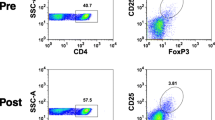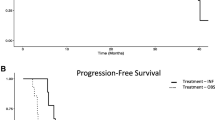Abstract
Background
Safety and cellular immunogenicity of rising doses and varying regimens of a poly-epitope vaccine were evaluated in advanced metastatic melanoma. The vaccine comprised plasmid DNA and recombinant modified vaccinia virus Ankara (MVA) both expressing a string (Mel3) of seven HLA.A2/A1 epitopes from five melanoma antigens.
Methods
Forty-one HLA-A2 positive patients with stage III/IV melanoma were enrolled. Patient groups received one or two doses of DNA.Mel3 followed by escalating doses of MVA.Mel3. Immunisations then continued eight weekly in the absence of disease progression. Epitope-specific CD8+ T cell responses were evaluated using ex-vivo tetramer and IFN-γ ELISPOT assays. Safety and clinical responses were monitored.
Results
Prime-boost DNA/MVA induced Melan-A-specific CD8+ T cell responses in 22/31 (71%) patients detected by tetramer assay. ELISPOT detected a response to at least one epitope in 10/31 (32%) patients. T cell responder rates were <50% with low-dose DNA/MVA, or MVA alone, rising to 91% with high-dose DNA/MVA. Among eight patients showing evidence of clinical benefit—one PR (24 months+), five SD (5 months+) and two mixed responses—seven had associated immune responses. Melan-A-tetramer+ immunity was associated with a median 8-week increase in time-to-progression (P = 0.037) and 71 week increase in survival (P = 0.0002) compared to non-immunity. High-dose vaccine was well tolerated. The only significant toxicities were flu-like symptoms and injection-site reactions.
Conclusions
DNA.Mel3 and MVA.Mel3 in a prime-boost protocol generated high rates of immune response to melanoma antigen epitopes. The treatment was well tolerated and the correlation of immune responses with patient outcomes encourages further investigation.




Similar content being viewed by others
References
King M, Spooner D, Rowlands DC (2001) Spontaneous regression of metastatic malignant melanoma of the parotid gland and neck lymph nodes: a case report and a review of the literature. Clin Oncol (R Coll Radiol) 13:466–469
Itoh K, Platsoucas CD, Balch CM (1988) Autologous tumor-specific cytotoxic T lymphocytes in the infiltrate of human metastatic melanomas: activation by interleukin 2 and autologous tumor cells, and involvement of the T cell receptor. J Exp Med 168:1419–1441
Schwartzentruber DJ, Topalian SL, Mancini M, Rosenberg SA (1991) Specific release of granulocyte-macrophage colony-stimulating factor, tumor necrosis factor-alpha, and IFN-gamma by human tumor-infiltrating lymphocytes after autologous tumor stimulation. J Immunol 146:3674–3681
Talebi T, Weber JS (2003) Peptide vaccine trials for melanoma: preclinical background and clinical results. Semin Cancer Biol 13:431–438
Pilla L, Valenti R, Marrari A, Patuzzo R, Santinami M et al (2006) Vaccination: role in metastatic melanoma. Expert Rev Anticancer Ther 6:1305–1318
Rosenberg SA, Yang JC, Restifo NP (2004) Cancer immunotherapy: moving beyond current vaccines. Nat Med 10:909–915
Rosenberg SA, Yang JC, Sherry RM, Hwu P, Topalian SL et al (2003) Inability to immunize patients with metastatic melanoma using plasmid DNA encoding the gp100 melanoma-melanocyte antigen. Hum Gene Ther 14:709–714
Triozzi PL, Aldrich W, Allen KO, Carlisle RR, LoBuglio AF et al (2005) Phase I study of a plasmid DNA vaccine encoding MART-1 in patients with resected melanoma at risk for relapse. J Immunother 28:382–388
Zhu J, Martinez J, Huang X, Yang Y (2007) Innate immunity against vaccinia virus is mediated by TLR2 and requires TLR-independent production of IFN-beta. Blood 109:619–625
Smith CL, Dunbar PR, Mirza F, Palmowski MJ, Shepherd D et al (2005) Recombinant modified vaccinia Ankara primes functionally activated CTL specific for a melanoma tumor antigen epitope in melanoma patients with a high risk of disease recurrence. Int J Cancer 113:259–266
McConkey SJ, Reece WH, Moorthy VS, Webster D, Dunachie S et al (2003) Enhanced T cell immunogenicity of plasmid DNA vaccines boosted by recombinant modified vaccinia virus Ankara in humans. Nat Med 9:729–735
Palmowski MJ, Choi EM, Hermans IF, Gilbert SC, Chen JL et al (2002) Competition between CTL narrows the immune response induced by prime-boost vaccination protocols. J Immunol 168:4391–4398
Therasse P, Arbuck SG, Eisenhauer EA, Wanders J, Kaplan RS et al (2000) New guidelines to evaluate the response to treatment in solid tumors: European Organization for Research and Treatment of Cancer, National Cancer Institute of the United States, National Cancer Institute of Canada. J Natl Cancer Inst 92:205–216
Xu Y, Theobald V, Sung C, DePalma K, Atwater L et al (2008) Validation of a HLA-A2 tetramer flow cytometric method, IFNgamma real time RT-PCR, and IFNgamma ELISPOT for detection of immunologic response to gp100 and MelanA/MART-1 in melanoma patients. J Transl Med 6:61
Balch CM, Buzaid AC, Soong SJ, Atkins MB, Cascinelli N et al (2001) Final version of the American Joint Committee on Cancer staging system for cutaneous melanoma. J Clin Oncol 19:3635–3648
Balch CM, Soong SJ, Gershenwald JE, Thompson JF, Reintgen DS et al (2001) Prognostic factors analysis of 17,600 melanoma patients: validation of the American Joint Committee on Cancer melanoma staging system. J Clin Oncol 19:3622–3634
Bedikian AY, Millward M, Pehamberger H, Conry R, Gore M et al (2006) Bcl-2 antisense (oblimersen sodium) plus dacarbazine in patients with advanced melanoma: the Oblimersen Melanoma Study Group. J Clin Oncol 24:4738–4745 Epub 2006 Sep 4711
Vaishampayan U, Abrams J, Darrah D, Jones V, Mitchell MS (2002) Active immunotherapy of metastatic melanoma with allogeneic melanoma lysates and interferon alpha. Clin Cancer Res 8:3696–3701
Ribas A, Camacho LH, Lopez-Berestein G, Pavlov D, Bulanhagui CA et al (2005) Antitumor activity in melanoma and anti-self responses in a phase I trial with the anti-cytotoxic T lymphocyte-associated antigen 4 monoclonal antibody CP-675, 206. J Clin Oncol 23:8968–8977 Epub 2005 Oct 8963
Hoos A, Parmiani G, Hege K, Sznol M, Loibner H et al (2007) A clinical development paradigm for cancer vaccines and related biologics. J Immunother 30:1–15
Schneider J, Gilbert SC, Blanchard TJ, Hanke T, Robson KJ et al (1998) Enhanced immunogenicity for CD8+ T cell induction and complete protective efficacy of malaria DNA vaccination by boosting with modified vaccinia virus Ankara. Nat Med 4:397–402
Harrop R, Connolly N, Redchenko I, Valle J, Saunders M et al (2006) Vaccination of colorectal cancer patients with modified vaccinia Ankara delivering the tumor antigen 5T4 (TroVax) induces immune responses which correlate with disease control: a phase I/II trial. Clin Cancer Res 12:3416–3424
Luescher IF, Romero P, Kuznetsov D, Rimoldi D, Coulie P et al (1996) HLA photoaffinity labeling reveals overlapping binding of homologous melanoma-associated gene peptides by HLA-A1, HLA-A29, and HLA-B44. J Biol Chem 271:12463–12471
Harrer E, Bauerle M, Ferstl B, Chaplin P, Petzold B et al (2005) Therapeutic vaccination of HIV-1-infected patients on HAART with a recombinant HIV-1 nef-expressing MVA: safety, immunogenicity and influence on viral load during treatment interruption. Antivir Ther 10:285–300
Wang F, Bade E, Kuniyoshi C, Spears L, Jeffery G et al (1999) Phase I trial of a MART-1 peptide vaccine with incomplete Freund’s adjuvant for resected high-risk melanoma. Clin Cancer Res 5:2756–2765
Peterson AC, Harlin H, Gajewski TF (2003) Immunization with Melan-A peptide-pulsed peripheral blood mononuclear cells plus recombinant human interleukin-12 induces clinical activity and T cell responses in advanced melanoma. J Clin Oncol 21:2342–2348
Benlalam H, Vignard V, Khammari A, Bonnin A, Godet Y et al (2007) Infusion of Melan-A/Mart-1 specific tumor-infiltrating lymphocytes enhanced relapse-free survival of melanoma patients. Cancer Immunol Immunother 56:515–526
Mackensen A, Meidenbauer N, Vogl S, Laumer M, Berger J et al (2006) Phase I study of adoptive T cell therapy using antigen-specific CD8+ T cells for the treatment of patients with metastatic melanoma. J Clin Oncol 24:5060–5069
Luckay A, Sidhu MK, Kjeken R, Megati S, Chong SY et al (2007) Effect of plasmid DNA vaccine design and in vivo electroporation on the resulting vaccine-specific immune responses in rhesus macaques. J Virol 81:5257–5269
Appay V, Voelter V, Rufer N, Reynard S, Jandus C et al (2007) Combination of transient lymphodepletion with busulfan and fludarabine and peptide vaccination in a phase I clinical trial for patients with advanced melanoma. J Immunother 30:240–250
Emens LA, Jaffee EM (2005) Leveraging the activity of tumor vaccines with cytotoxic chemotherapy. Cancer Res 65:8059–8064
Acknowledgments
We are indebted to the patients that participated in this trial and their families. Also to the specialist nurses and medical staff who managed the patients. The following individuals provided advice and expertise—statistics and data management: Paul Talsma and Steve Turner, Synequanon Ltd (Diss, UK); data monitoring: Constella Group Inc. (Abingdon, UK); immunomonitoring: Carmen Scheibenbogen (Charité Hospital, Berlin, Germany); The Melanoma Study Group: A. Busse; S. Ugurel; A. Thoelke; G. Mousse; J. Curran; S. Pratap; G. Pearce; K. Whale.
Author information
Authors and Affiliations
Corresponding author
Rights and permissions
About this article
Cite this article
Dangoor, A., Lorigan, P., Keilholz, U. et al. Clinical and immunological responses in metastatic melanoma patients vaccinated with a high-dose poly-epitope vaccine. Cancer Immunol Immunother 59, 863–873 (2010). https://doi.org/10.1007/s00262-009-0811-7
Received:
Accepted:
Published:
Issue Date:
DOI: https://doi.org/10.1007/s00262-009-0811-7




